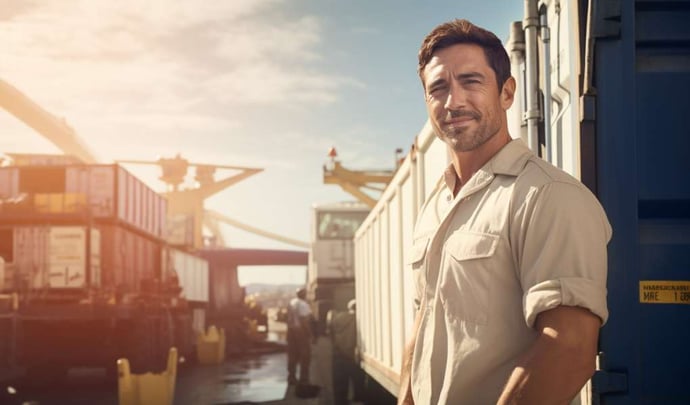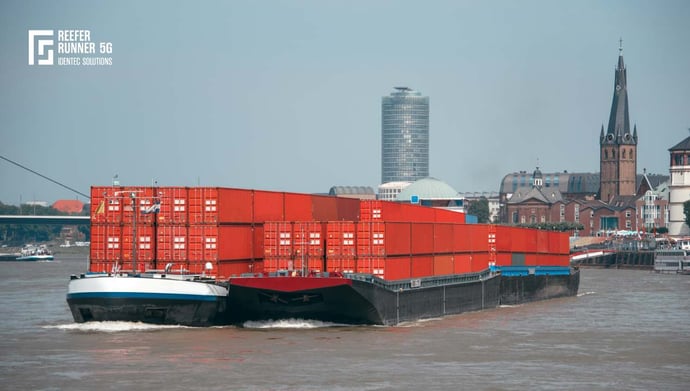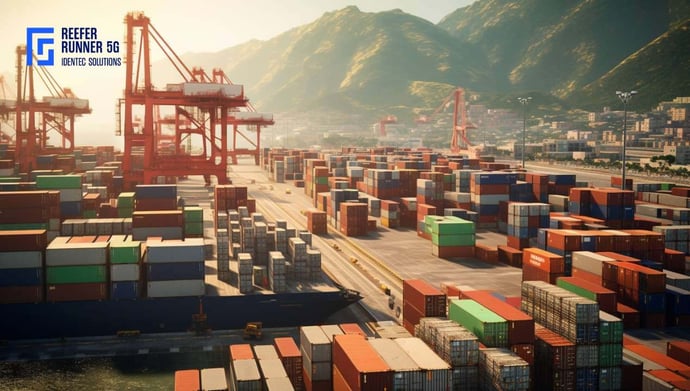River Barges, the Rhine and Remote Reefer Monitoring
| Written by Mark Buzinkay

No video selected
Select a video type in the sidebar.
The river Rhine as a transportation route
The Rhine, stretching approximately 1,230 kilometres (760 miles), is Central and Western Europe's second-longest river, following the Danube (see also: Danube transport). It has an average flow rate of around 2,900 cubic meters per second and drains a basin covering 9,973 square kilometres, including North Switzerland, the Alsace, Luxembourg, southern Belgium, parts of western Germany and most of the Netherlands.

The Rhine, recognized as one of the world's busiest inland waterways, sees significant daily vessel traffic, varying notably along its course. Approximately 600 vessels cross the Dutch-German border daily, while 400 navigate through Cologne, 300 through Mainz, 200 in Karlsruhe, and 100 at Iffezheim. These vessels contribute to the substantial volume of goods transported, with about 200 million tonnes recorded at the German-Dutch border and an estimated 310 million tonnes along the Dutch section of the river. The diverse fleet on the Rhine comprises roughly 6,900 vessels, which include 1,200 pushed barges, 4,400 motor cargo vessels, and 1,300 tankers, collectively offering a transport capacity of 10 million tonnes (1).
The River Rhine extends its connectivity well beyond its natural drainage basin through a series of canals, thereby facilitating access to an extensive area, including cities like Paris, Lyon, Amsterdam, Berlin, Hamburg, and regions such as the Baltic Sea, Vienna, Belgrade, and the Black Sea. These connections are made possible by several key waterways: the Rhine–Main–Danube Canal in southeastern Germany, the Grand Canal d'Alsace in eastern France, the Rhine-Herne Canal in northwest Germany (which links to the Dortmund-Ems Canal and the Mittellandkanal), the Maas-Waal Canal in east-central Netherlands, the Amsterdam-Rhine Canal in central Netherlands, and the Scheldt-Rhine Canal in southwest Netherlands.
Rhine transport is subject to the seasonal conditions of the river, with both low and high water levels presenting risks, particularly with fixed structures such as bridges. Various organizations monitor the river's conditions and provide updates to vessel operators (RIS - River Information Services). To enhance navigation and manage the variability of these conditions, artificial canals and locks have been constructed along the natural course of the river, ensuring a more consistently navigable waterway.
Where Are Industrial Hubs along the River Rhine?
Basel
Basel and its surrounding area are renowned for a thriving pharmaceutical sector, with the city claiming the world's highest concentration of successful life sciences companies. These companies contribute the majority of the region's economic value, with notable firms like Novartis, Roche, Lonza, Bayer, BASF, Syngenta, Straumann, and Moderna maintaining headquarters or significant operations here. In 2020, the pharmaceutical industry in Basel employed approximately 47,000 people and generated a gross value of 36.8 billion CHF. The region's Rhine terminals facilitate the import of raw materials in large volumes and serve as export hubs for pharmaceutical products, primarily shipped in dry containers and reefers, linking Basel to major seaports.
Strasbourg
Strasbourg, often dubbed the capital of Europe, is a critical centre for manufacturing and engineering, as well as a key hub for road, rail, and river transport. The city's diverse economic activities span food processing, mechanical and electrical engineering, and the manufacturing of pharmaceuticals, electronics, and plastics. Among its leading sectors, Strasbourg has established itself in medical technologies and therapeutic innovation, notably with the creation of Campus Tech Med, which is recognized internationally for its medical instrumentation and technologies. Additionally, the city is advancing innovative and multimodal mobility solutions, aiming to become a leader in future urban transport systems. Strasbourg's economy is also characterized by a strong international presence, hosting 1,200 international companies.
Duisburg
Hosting Europe's largest steel site and the world's largest inland port, this city, with a population of half a million, serves as an internationally significant logistics hub and marks both the beginning and the terminus of the new Silk Road. The city also thrives on technology and service industries. A key advantage is its strategic location on the Rhine and Ruhr rivers, bridging the polycentric Ruhr metropolis, the Rhineland, and the Lower Rhine. The infrastructure is top-notch, with excellent connections to highways, airports, and rail networks. The Duisburg Rhine terminals are one of the biggest and busiest along the river.
Rotterdam
Rotterdam is widely recognized as the gateway to Europe, situated at the heart of the continent's largest maritime cluster. The port of Rotterdam has long been integral to north-western Europe's role as an importer of fossil fuels and a producer of energy and chemical products. Its robust network of pipelines and transportation options links directly to Antwerp and the Rhine-Ruhr area, giving Rotterdam significant sway over oil product pricing.
The city's industry-energy complex contributes approximately €10.5 billion in added value and supports 54,000 jobs, positioning Rotterdam's chemical cluster on par with those in Houston, Singapore, and Shanghai. In the forthcoming decades, this complex is set to undergo a transformation as regional giants strive to establish the world's first sustainable industrial complex. This ambition positions Rotterdam as a burgeoning hub for the sustainable processing, production, storage, and distribution of raw materials and chemical products, as well as a centre for renewable and climate-neutral energy and fuels.
Rotterdam's port offers unparalleled flexibility and a comprehensive array of facilities compared to other ports in north-western Europe. Its shipping networks—deep sea, short sea, and inland, along with extensive rail and road links to Europe's hinterland—are unmatched. With a depth of nearly 24 meters, the port can handle large container ships without the need for locks or tidal restrictions and is strategically located at the confluence of Europe's two major rivers, often making it the first or last European port of call. Furthermore, connections to over 1,000 global ports underscore Rotterdam's pivotal role as the main hub for European cargo logistics—a status achieved through sustained investment in networks, infrastructure, and services (2).

Scheduled River Barges along the Rhine
Several logistics companies, including Contargo, Danser, and Ultra-Brag, are dedicated to establishing robust connections between the inland terminals along the Rhine and Main rivers and major western sea ports like Antwerp, Rotterdam, and Amsterdam. They utilize established routes and dependable schedules to provide comprehensive logistics solutions to the industrial regions along the Rhine. Major players such as DP World and Hutchison also maintain a significant presence along the river, with various container terminals serving as logistical hubs for the hinterland.
A prime example of collaboration on the river is the partnership between Danser Group, Swissterminal, and DP World. This cooperation seeks to create a sustainable, reliable, and flexible inland shipping service connecting the border triangle with the West Sea ports. Operating with two weekly departures, their coupled barges link terminals in Birsfelden, Basel, Ottmarsheim, and Strasbourg directly with the largest European deep-sea terminals in Rotterdam and Antwerp. This customer-oriented transport solution is designed to optimize logistics processes and enhance competitiveness. Alongside its Schweizerzug service, Swissterminal has developed a redundant transport system that strengthens the critical axis between the hinterland and the West Sea ports, using four coupling units and providing capacity for 342 to 348 TEUs per vessel, including 24 to 32 reefer slots.
Contargo provides another testament to the extensive network of logistic capabilities. Its fleet comprises 38 barges and 18 push barges, transporting 13,498 TEUs across the Rhine, linking ARA ports to the European hinterland. With high load capacities and a dedicated fleet operating on fixed schedules, Contargo reduces the strain on both road networks and the environment. Their barges maintain regular journeys with reliable speed; for instance, travel time from the western ports to Basel averages 3.5 days for exports and 5 days for imports, while the Rotterdam to Duisburg route requires just 1 day for export travel and 1.5 days for imports. Additionally, a network of 24 inland terminals facilitates optimal transport of empty containers.
River barges for reefer logistics
Reefer logistics plays a crucial role in the cold chain, using reefer containers to transport perishable goods such as fresh fruits, vegetables, frozen meat, fish, and sensitive food items like chocolate, wine, and pharmaceuticals. These goods are exported and imported year-round via the Rhine, which serves as a major transportation route.
Monitoring reefers is essential for maintaining the quality and safety of these perishables while in transit. It also helps minimize wastage and spoilage, which can be financially burdensome for companies. Reefer monitoring typically involves checking the temperature and humidity inside the containers, as well as CO2 levels and other gases. It's also necessary to ensure the reefer unit is functioning, the power supply is continuous, and the settings are correct. Traditionally, such checks require manual intervention every six hours, a task made challenging by the movement of the ship, the narrow spaces between containers, limited visibility, and the height at which controllers are mounted.
To address these challenges, remote, automated reefer monitoring has become the norm in container terminals and depots. Increasingly, cold chain logistics companies and vessel captains are adopting mobile solutions that allow them to manage and monitor reefers directly from the bridge during a voyage. This automated approach not only spares the crew from manual checks but also alerts them to any issues with a reefer unit. At the journey's end, it generates an automated trip report that includes comprehensive data on temperature, humidity, and other relevant metrics, ensuring transparency and accountability at the point of delivery.
What is The future of river barges on the River Rhine?
Following the 2018 Mannheim declaration, ministers from CCNR Member States urged the organization to accelerate the integration of digitalization, automation, and advanced technologies in inland navigation (1). This push is aimed at enhancing the sector's competitiveness, safety, and sustainability.
Inland waterway transport is evolving beyond its traditional role, positioning itself as a conduit for sustainable, forward-looking logistics solutions. By 2024, the first electric barges are set to be seen on the River (joining the Contargo network). The strategy seems clear: diverting as much cargo as possible from roads to more sustainable transport modes like barges. This transition not only cuts costs for customers but also reduces CO2 emissions per tonne-kilometre, contributing to environmental preservation. Daily road traffic in Germany incurs economic costs of about 200 million euros, with 13 million working hours lost to traffic jams and 33 million litres of diesel consumed. In contrast, barge transport offers a superior environmental profile, free from the constraints of traffic jams and restrictions on Sunday travel, underscoring its advantages in sustainability and efficiency.
Kay Metzger, CEO of Danser Switzerland, says that Inland shipping, like other modes of transport, is at a turning point. The objectives of the Mannheim Declaration aim to reduce emissions from inland shipping by 35% by 2035 compared to 2015 and to eliminate these by 2050 largely. This is challenging but incredibly exciting. Danser has already contributed to achieving these goals. For example, in 2015, we converted one of our push-tow formations to LNG and fuel ships with GTL (3).
Continue reading: Autonomous vessel on the Rhine
Takeaway
Remote reefer monitoring on the Rhine has become essential for ensuring the safe and efficient transportation of perishable goods along this vital waterway. Leveraging advanced technologies, logistics companies have adopted automated systems to monitor conditions within reefer containers, such as temperature and humidity, without the need for manual checks. This automation not only maintains the quality and integrity of temperature sensitive cargo like fresh produce and pharmaceuticals but also enhances the operational efficiency of river barges. As the Rhine continues to serve as a major route for the movement of goods across Europe, the implementation of remote reefer monitoring stands out as a key development in modernizing river transport and reducing environmental impact.
Delve deeper into one of our core topics: Cold Chain Monitoring
Glossary
Pushed barges are unpowered flat-bottomed vessels that are manoeuvred by a pusher tugboat, forming a single, connected unit for transporting goods on rivers and canals. This method improves efficiency and capacity compared to self-propelled vessels. Pushed barges are commonly used for bulk commodities like coal, grain, and chemicals. Their modular design allows flexibility in cargo transport and cost-effectiveness, especially for inland waterways. (4)
Sources:
(1) https://www.ccr-zkr.org/12030100-en.html
(2) https://www.rotterdammaritimecapital.com/ecosystem/port-logistics
(3) https://loginfo24.com/magazine/transport-ch_magazin_01-23/
(4) Benford, H. Inland Water Transport. Elsevier, 1984.
Note: This article was updated on the 22nd of January 2025

Author
Mark Buzinkay, Head of Marketing
Mark Buzinkay holds a PhD in Virtual Anthropology, a Master in Business Administration (Telecommunications Mgmt), a Master of Science in Information Management and a Master of Arts in History, Sociology and Philosophy. Mark spent most of his professional career developing and creating business ideas - from a marketing, organisational and process point of view. He is fascinated by the digital transformation of industries, especially manufacturing and logistics. Mark writes mainly about Industry 4.0, maritime logistics, process and change management, innovations onshore and offshore, and the digital transformation in general.
Related Articles
Related Product



